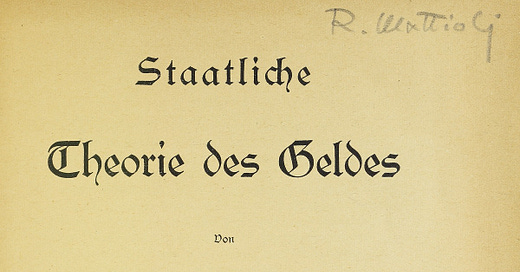The question about why a certain money is used –or, more specifically, what is the basis of monetary demand– has concerned economists for a long time. Several argue that it is the need to pay taxes –and the various forms that it has taken during history– in that money that fosters the demand for it. In a nutshell, money is used and demanded due to the fiscal obligations in it. This is the premise of chartalism, generally conceived as the invention of Georg Friedrich Knapp.1
Opposed to this current of thought, metallists believe that the main reason why money is accepted is the preference of economic units for a commodity whose value is stable across time and space. Therefore, this money would now be used as a common denominator for exchanges between individuals, encouraging commerce and economic calculation. Let’s, for the sake of the argument, imagine a shipment of thirty pounds of oil from A to B. For whatever reason, the unit pound is not standardized, and everyone measures it in their own way. Obviously, how would anyone be willing to exchange in the pound unit if no one knew what the pound was at any given moment? The same applies to money and the relevance of the stability of value.
Neither and both are right, as they point out a particular way of money to origin. Just as Mises’ Regression Theory rejected the possibility of a good that had not been exchanged in the marketplace to become money –which turned out to be mistaken when fiat money emerged–, chartalists did not consider the relevance of the properties of money. It does not only matter whether money is accepted or not, but also the price at which it is exchanged with other commodities –the stability of value. Anyone would be willing to purchase Argentine peso if the price were so low to compensate the buyer. Does that mean that the Argentine peso is a good money? Obviously not. Again, price and stability matters. Moreover, chartalism cannot explain why non-Americans hold dollars in their balance sheet even if they do not pay taxes in the US. Few critiques of chartalism have been seen as critical as Allyn Young’s:
There is a widespread illusion […] that it is the power and authority of the government which give the coin its value. This notion has done a vast amount of harm, and more than once it has been used by governments as an excuse for unsound monetary policies. […] just so far as the government in its own transactions does not discriminate among these different types of coins and just so far as it remains able and willing to exchange any one type of coin for any other sort, just so far will the business world accept these coins as of identical value per dollar (Young, 1924).
The value of fiat money –the one created by the State– depends, like any other financial asset, on the expected future cash flows, and economic agents are aware that any State willing to use its fiscal and monetary power to stabilize currency can provide a source for liquidity. The dollar is the worldwide reserve currency because the Fed and the US are backing it. But, most importantly, because they have proved to prioritize the value of the dollar beyond any macroeconomic variable.
While metallism can in explain the origin of fiat money, as it is used as a value deposit and medium exchange freely around the globe, the mistake comes when the role of the State in accelerating the widespread use of money is underplayed. A State forcing the use of fiat money is not a sufficient nor necessary condition for money to emerge in a democratic society, as Saifedean Ammous pointed out in The Bitcoin Standard, where he explores the different origins of money in history. Although, that does not mean that a fiat money provided by the State cannot become a monetary standard that can provide a safe medium of exchange and a value deposit.
References
Young, Allyn (1924). The Mistery of Money. How modern methods of making payments economize the use of money. The role of checks and bank notes. The Book of Popular Science. New York: The Grolier Society.
Though this article will not be devoted to this debate, Rallo argued against this interpretation of Knapp’s work in an article called Georg Friedrich Knapp was not a Chartalist [https://read.dukeupress.edu/hope/article-abstract/52/4/773/165508/Georg-Friedrich-Knapp-Was-Not-a-Chartalist?redirectedFrom=fulltext]



